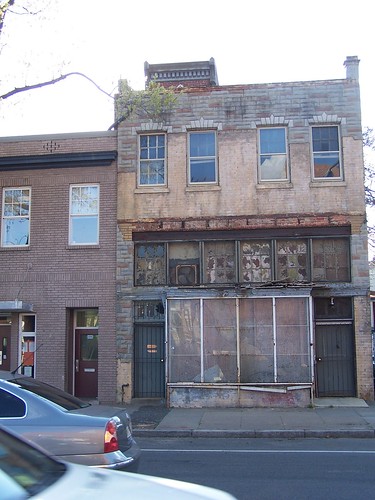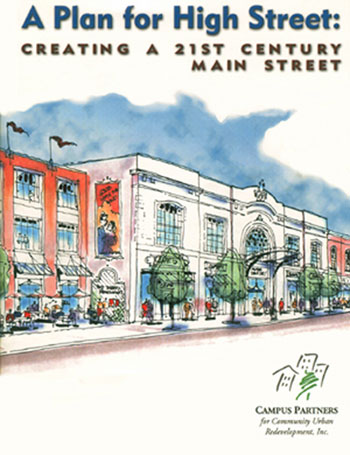Understanding neighborhood change... and still doing nothing about it
In Understanding Neighborhood Change, Goetze discusses how homebuilding in the suburbs at a rate far greater than demand led to a wholesale abandonment of property in the center city.
Lately I have been thinking a lot about a couple things:
1. what I call intra-city sprawl
2. and the failure to coordinate new investment within cities in ways that strengthen extant investment.
The latter is complicated by the fact that infill devleopment is a pain in the a** in terms of having to deal with complications but more importantly having to deal with citizens and other property owners. As a result it's a lot easier to develop a big piece of land, whether it is a greenfield, grayfield, or brownfield.
Intra-city sprawl is the practice of authorizing new development or moving facilities without much consideration of extant agglomeration economies--being close to other services, amenities, and extant transportation infrastructure. The best example is the proposal to move the DC police department offices from Judiciary Square, where the department is next to the Courts, across the street from a main City Government office building and a few blocks from City Hall, plus steps from the Judiciary Square red line subway station, to a location on Jersey Avenue SE that is far away from everything, and a few blocks away in either direction, from subway connections, and with little if any bus services.
DC Government does not require itself to do transportation demand management planning and it shows...
Intra-city sprawl is also developing new stuff without thinking about the impact on the extant. New development can be constructed and planned in a manner that strengthens extant places, rather than further degrading them. E.g., instead of building a hotel at Irving and Michigan Avenue, a few blocks away from the Brookland commercial district, why not build it next to the Metro? After all, the land that is being developed is city-owned. So why don't city government agencies do projects in ways that support other city policies?
Linkage funds (community benefits) should be directed to ensuring this happens.
A good example is the DC Convention Center.
9th Street NW by the Convention Center is a dog, although improving. See "A Thwarted Renaissance Near the Convention Center," from the Post. The area closer to U Street is experiencing some success, as well as the area around the Giant Supermarket.)
Had money from the construction of the Convention Center been spent simultaneously on improving the buildings along 9th Street NW and incentives for populating the buildings with quality retail been provided, it may have been possible to accelerate improvement over there by many years.

If we can spend hundreds of millions of dollars on a lightly used Convention Center, why not a little more to ensure that the new development complements the old, rather than continuing the degradation.
Instead, it's still a struggle. Having overall priorities to how develop should occur and how linkage monies should be spent are a necessary first step. Such policies should be in place before new development, not afterwards when the requirements have no effect.
Route 1 from the College Park Campus to Hyattsville has some similar things going on.
The East Campus project at UMD will bring an incredible amount of retail online. Look at their diagram and you see they have little room for independent retail.
The Cafritz development in Riverdale Park is using the seduction of a Whole Foods Supermarket in an area that is understored in terms of "high quality" retail to bring another couple hundred thousand square feet of retail space to the Route 1 corridor.
This, in an area where the quality of independent retail, despite Franklins Restaurant in Hyattsville, is lacking and continues to sputter despite the best efforts of various entities.
Without planning to address this from the outset, without requiring linkage, improvement along the corridor in terms of the extant retail is not likely to happen.
What I recommend is:
1. Creating a Route 1 Redevelopment Corporation, maybe amalgamating the Hyattsville CDC and the Gateway CDC in the process. The model I am thinking of is the Portland Development Commission in Portland, Oregon. They don't have a bunch of quasi-government CDCs across the city, they center the expertise and capacity within one agency.
2. Creating an Urban Renewal District for this area and selling bonds against the anticipated property and sales tax revenue increases. The example I am thinking of is the Interstate Urban Area, again in Portland. To pay for the construction of the Interstate or Yellow Max line, the city created this Urban Renewal District.
For more info, see this article "The state of Interstate: Zoning proposals stress transit usage, higher densities," from the Portland Tribune. Also this story, in advance of the opening of the line, "Where tracks rise, so do hopes."
3. Have streetscape, building, and signage standards in the URD.
4. Use the TIF monies as another form of linkage to improve:
a. the physical condition of Route 1's streetscape
b. the construction of a streetcar system on Route 1, ideally between the Rhode Island Avenue Metro Station and College Park, but it could go as far as Laurel eventually (I've written about this for a couple years).*
d. support for the development of new independent retail business in the coming new space, as well as for the retention and improvement of independent retail and buildings currently in place on Route 1 in the target area.
5. Requiring standards for the construction form, height, amount and funding of independent retail, and transit connectivity for the new development.
* The State of Maryland studied a streetcar system for the Rte. 1 corridor in the mid-1990s. I have a CD of the report, but I haven't worked through it yet.
Some old stuff to read...
1. Hyattsville Community Legacy Revitalization Plan
2. Gateway Arts District Sector Plan
3. Approved Anacostia Trails Heritage Area Management Plan
4. EPA-produced Achieving the Vision: Options for the College Park U.S. Route 1 Corridor
And out of the area:

5. Somewhere I have a hard copy of this document from the High Street revitalization project in Columbus, Ohio; they also have a companion document on streetscape and design standards
6. There are also the new books by Wim Wievel, The University As Urban Developer: Case Studies And Analysis (Cities and Contemporary Society), and Judith Rodin, former president of the University of Pennsylvania, The University and Urban Revival: Out of the Ivory Tower and Into the Streets (The City in the Twenty-First Century), I have to admit I haven't read either, although I've suggested to Catholic University that they do a mini-conference on universities and revitalization...
Labels: commercial district revitalization, regional planning, university-community revitalization, urban design/placemaking



0 Comments:
Post a Comment
<< Home